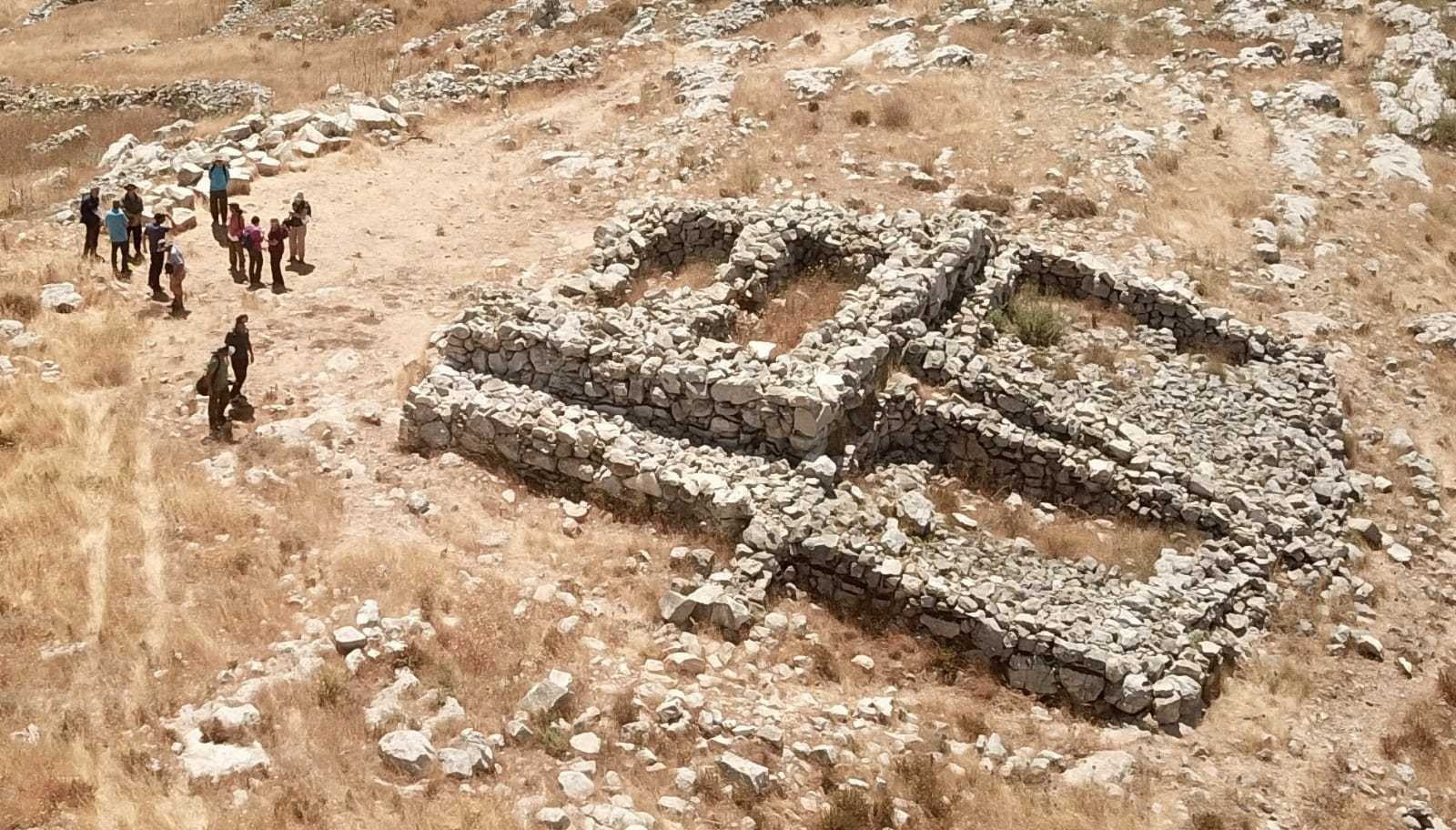When the discovery of a small lead “curse tablet” was announced last year, it was hailed by many as one of the most significant archaeological discoveries in recent times. But since the announcement, many have come out to shadow the discovery in skepticism. Dr. Scott Stripling, an archaeologist who has been sifting the sands of the Biblical heartland for more than two decades, responded to a recent article criticizing his find.

In December 2019, Dr. Stripling, Director of the Archaeological Studies Institute at The Bible Seminary in Katy, Texas, led the expedition from the Associates for Biblical Research (ABR) to Mt. Ebal to wet sift the discarded material from Zertal’s excavation and discovered the small (2 x 2 centimeter) folded lead tablet.

The earliest Hebrew writing previously found—the Khirbet Qeiyafa ostracon found in the dig at the ancient fortress city near the central Israeli town of Beit Shemesh—was dated from 1000 BCE, making the inscription on this tablet 200 to 400 years older. Its use of the Hebrew word for God also predates the oldest previously found in Israel by 500 to 600 years. If the dating of the tablet is accurate, it may add to the evidence that the exodus from Egypt was earlier than previously believed.
The discovery had implications for the study of both the Hebrew Bible and the New Testament and was controversial from its announcement. It could also indicate that the Israelites entered the Land of Canaan hundreds of years before it is commonly held that they did so.
It could also indicate that the Israelites were already literate at that time, meaning they could have written parts of the Bible when the depicted events were taking place, instead of generations later, as was previously accepted among some scholars.
A recent article in the archaeology section of Haaretz written by Ariel David presented the views of skeptics, one of whom claimed the small lead tablet was nothing more than a fishing weight and the inscriptions were random scratches.
This was followed by an article in the Times of Israel by Gavriel Fiske reporting on three peer-reviewed academic articles published this week that attempted to cast doubt on the authenticity of the tablet.
“Detractors claim that the soft metal object is simply dented and marred, and no script can be discerned from the released photographs or images,” the TOI article stated, citing Dr. Aren Maeir of Bar-Ilan University, a co-author of one of the new papers, as saying that the level of documentation Stripling and his team provided is “below par,”.
“They haven’t provided the evidence for it,’ Dr. Maeir told TOI. “I will be happy to change my mind, but they haven’t provided the evidence, and until they do, we have to base [our opinion] on what is published,”
He noted that it was very unusual to have three articles published “back to back” rebutting an archaeological find.
Dr. Stripling responded.
“Maeir is an Israel Exploration Journal editor, and the three articles were clearly coordinated,” Dr. Stripling told Israel365 News. “Journals often have multiple articles on the same topic in the same issue, so it is unclear to me why he believes this is unusual.”
Dr. Stripling agreed emphatically with the TOI article’s assertion that the three articles represented a “concentrated effort to debunk the findings”
“They certainly do but should editors be evaluating their own articles?” Dr. Stripling asked.
Stripling also noted that the tomographic technology used to reveal the writing is cutting-edge.
“When working with tomographic scans, unfortunately we do not have the quality of documentation we are all accustomed to seeing,” Dr. Stripling said. “In this way, it is different from other methods previously used in such research.”
It should be noted that many archaeological finds are considered controversial before they pass the scrutiny of other researchers and are accepted.
Dr. Stripling also corrected the TOI article noting that if accepted, the 3,200-year-old “curse tablet” would indeed be the oldest known found in Israel. The TOI article wrote that it would push back the accepted date of Israelite literacy by some 500 years.
“This should read 300,” Der. Stripling noted. “Not 500.”
Perhaps most egregiously, the TOI article accused Stripling and other religiously observant archaeologists of interpreting their scientific findings through a religious lens.
“Maeir asserted that in the case of the ‘curse tablet,’ ideological and religious beliefs could be trumping scientific accuracy, ” the article wrote. “Stripling, ‘a very conservative Baptist,’ has a record of making ‘statements that are iffy from an archaeological point of view in an attempt to “prove aspects of how he sees and understands the biblical text.”
Dr. Stripling responded.
“I am not a Baptist,” Dr. Stripling corrected. “And I have no idea where Maeir got this idea. His comments here are ad hominem and unfounded. They are beneath the dignity of a scholar of his stature.”
It should be noted that Adam Zertal, who discovered the site on Mount Ebal in 1981 and identified it as the Biblical site of Joshua’s altar, was not religious.

Indeed, many prominent archaeologists who made Biblically significant discoveries were not personally religious. Eilat Mazar, who passed away in 2021, was a key figure in Biblical archaeology noted for her discovery of the Large Stone Structure, which she surmised to be the palace of King David, and many other artifacts that were Biblically significant. These findings were all contested, mainly by archaeologists who adhered to the Biblical minimalist school of thought and doubted the existence of King David and the historicity of the Bible’s accounts of the Davidic dynasty.
Mazar, who did not self-define as religious, was a biblical maximalist and, according to herself, “I work with the Bible in one hand and the tools of excavation in the other, and I try to consider everything.”
The TOI article inexplicably discounted Dr. Stripling’s conclusions based on current Middle Eastern politics.
“The whole thing is fraught with difficulties,” Maeir, from Bar-Ilan University, insisted. He noted there is also “a lot of political background noise” in regards to the artifact, because the Mount Ebal site is in the West Bank, and so ‘is a focus for right-wing settlers… [these theories are] proving Israel’s claim’ on the territory.”
Dr. Stripling, a US citizen who lives in Texas and not in Israel, was perplexed.
“Wow, if someone lives in Judea and Samaria and disagrees with Maeir on this topic, he or she is a right-wing settler?” Dr. Stripling said.
Politics, does, however, enter into the Ebal site as the Palestinian Authority is actively working to destroy the site in an effort to erase the historic connection between Samaria and the Jewish people.

It should also be noted that Dr. Maier’s statement is anachronist, using politically laden terms like “West Bank:” and right-wing settlers. It would be far more accurate to place Mount Ebal in Samaria.
In conclusion, Dr. Stripling contested Maier’s discounting of the Bible as a valid tool for archaeologists, insisting that archaeology has been “used and misused for ideology, not just in Israel but throughout the world.”
“Professional archaeologists have to work as hard as possible to distance themselves from that. They are saying there is a very clear inscription with a clear connection at a site with a clear biblical event… it adds a whole layer of imagined interpretation to the archaeological remains. “As a serious scholar, I can’t accept that. If you want to add that, prove it! You can’t just say, here are some blurry photographs, so believe me,” said Maeir.
Dr. Stripling rejected that claim.
“Maier has no problem connecting archaeological remains with Egyptian or Mesopotamian literature, but we dare not do that with the biblical literature,” Dr stripling explained. “Give me a break. We did not say there is a ‘very clear inscription.’ We are dealing with tomographic scans that are not as clear as we would like.”
“Just look at the van der Veen and Stripling drawings in the Heritage Science article. Is Maeir implying that he is a serious scholar and we are not serious scholars? He writes ‘you can’t just say,” but that is exactly what he and Rolston do in their article. He provides no citations or parallels to buttress his contention that we are misreading the pottery and the scarabs. We cite Daphne Ben-Tor, Israel’s most renowned scarab expert, and they ignore her analysis. Professor Maeir’s approach seems to be that it is so because he says it is so.”



